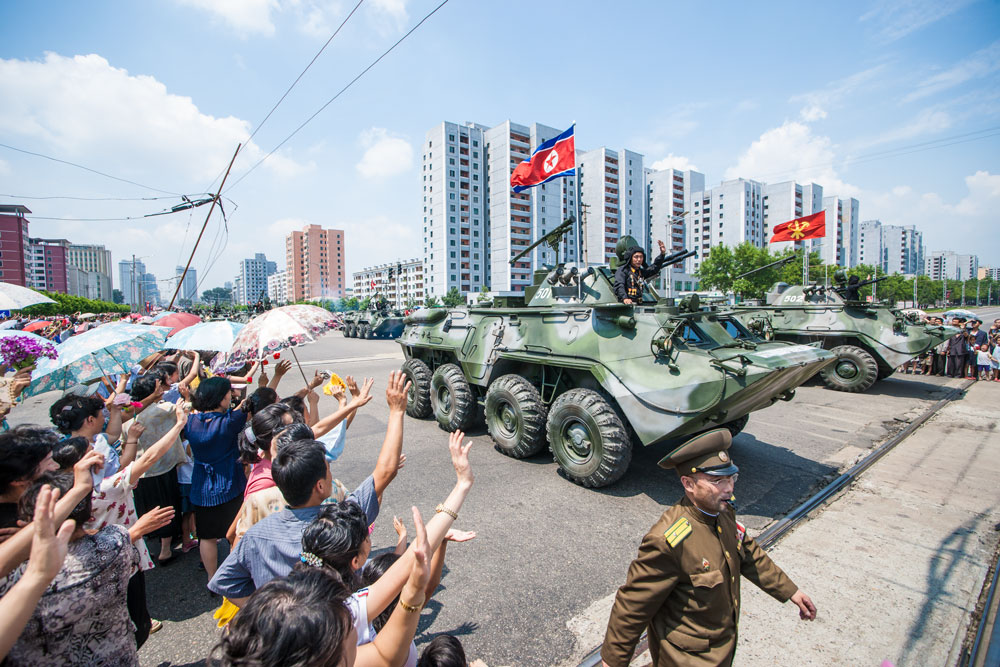 Spectators wave to tanks at a North Korean military parade in 2013. (Uri Tours)
Spectators wave to tanks at a North Korean military parade in 2013. (Uri Tours)
A Ballistic Dis-Missile? Reevaluating North Korea’s Nuclear Threat
North Korea recently displayed four new massive intercontinental ballistic missiles (ICBMs) during a mid-October military parade celebrating the 75th anniversary of the Korean Workers Party, the party of the Kim regime. At a Pentagon meeting, U.S. Secretary of Defense Mark Esper stated that he and the South Korean Defense Minister Suh Wook “agree that North Korea’s nuclear and ballistic missile programs remain a serious threat to the security and stability of the region and the world.” But given North Korea’s continued posture of aggressive deterrence, does another ICBM — albeit huge — really change the game? Let’s break this down.
What’s the Deal with that Missile?
Kim Jong-Un made good on his December 19 claim that he would soon reveal a “new strategic weapon.” The sheer enormity of the weapon caught the attention of the Internet and was enough to instill fear, but the implications of the parade lie far beyond the appearance of the missile itself. Currently dubbed the Hwasong-16, this huge ICBM is made more unique by the fact that it appears to have been carried by a massive 11-axle transporter erector launcher (TEL), hypothetically permitting the ICBM to be quickly moved and launched directly from the bed of the TEL.
North Korea has developed its posture with frequent nuclear and ICBM tests with weapons that can allegedly reach anywhere in the United States. Its predecessor, the Hwasong-15, has already been demonstrated to have this potential with a 500 kg warhead, suggesting that the Hwasong-16 could carry a heavier warhead with an even greater nuclear yield. Its lethality could also be predicated upon other technologies, including the possibility of a missile payload containing multiple independently targetable reentry vehicles (MIRVs) to strike different targets at once. While there is no solid evidence that the state has developed this capability yet, it is a logical progression in the path of nuclear weapons development.
Diplomacy Amidst a Deteriorating American Reputation
North Korea’s “style” of deterrence is aggressive, intended to appear volatile and irrational because the Kim regime knows it will lose any type of war; the appearance of the Hwasong-16 merely reaffirms this. At this parade, Kim reaffirmed the nature of the weapons as a deterrent as well as a potential first strike. However, Kim also avoided any particularly militant rhetoric toward the United States, indicating that there may still be a tiny gap in the metaphorical open door of diplomacy.
After the failed third Trump-Kim summit in 2019, during which North Korea reiterated that it would categorically refuse to fully denuclearize, this large nuclear weapon is another step in the wrong direction, but the trend in the wrong direction is of no surprise. ASP previously discussed the implications of a U.S. withdrawal from the Joint Comprehensive Plan of Action (JCPOA, or Iran Nuclear Deal) and what that would mean for U.S.-North Korea relations, concluding that this U.S. posture demonstrates that it is not to be trusted when it comes to nuclear agreements. Now that the U.S. has officially withdrawn from the agreement, this may have precluded the opportunity to reach a deal with North Korea.
A U.S. Approach Going Forward
The North Korea problem has plagued the U.S. for years, but the emergence of the Hwasong-16 may simply just be another tactic to renew and reaffirm its nuclear posture. North Korea’s ability to develop not just one, but four, of these massive weapons primarily suggests that its nuclear weapons production capabilities are only rising, strengthening the need for credible diplomatic efforts. Additionally, the more North Korea builds, the more it will need to be convinced to dismantle, thereby strengthening North Korea’s bargaining position. Meanwhile, the U.S. position appears to be getting weaker, as the withdrawal from the Iran Nuclear Deal and subsequent sanctions on Iran have challenged U.S. diplomatic credibility. America needs to rebuild its international reputation as a negotiation partner — and quickly.
For better or for worse, the Hwasong-16 merely reaffirms what the U.S. already knows: that North Korea is a legitimate nuclear threat that must not be forgotten amidst standoffs with other adversaries like China. No matter the Hwasong-16’s true capabilities, its presence is a cautious reminder and clear demonstration that past U.S. diplomatic efforts have failed and that North Korea still intends to push the envelope on its nuclear expansion. The other weapons displayed during the parade, including short-range ballistic missiles (SRBMs) and submarine-launched ballistic missiles (SLBMs), pose compounded threats that involve all domains in which the United States and its regional allies should concern themselves.
Despite having more questions than answers, one thing’s for sure: whoever he may be, the next president will undoubtedly have plenty on his hands.





